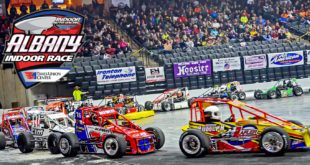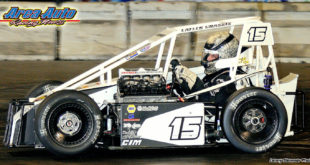TQ MIDGET INDOOR SERIES RULES
TQ Midgets & 600cc Micro Sprints Competing Head to Head In All Competition
ENGINES –
– All car must be self starting
– 4 Stroke motors only.
– Fuel injection or carburetors may be used.
– No forced induction or nitrous is allowed.
– No Current Year Motors Allowed.
A. TQ MIDGETS – 750cc Maximum Displacement
– All engines must be production 750cc motorcycle engines.
– Engine must be stock in appearance. No porting.
– No Current Year Motors Allowed. All motors must be 2014 or older.
– Must run Racing gasoline sold at the event only (112 octane / No additives).
– No rear engine cars. Driveshaft and rear end only.
B. 600 MICRO SPRINTS – 637cc Maximum Displacement
– All engines must be production 600/636cc motorcycle engines.
– Open motor rules. Engines may be ported.
– Choice between racing grade methanol or racing gasoline sold at the event (no additives).
– No rear engine cars, chain driven only.
C. SPEC MUFFLER: Steel 600/1000cc muffler sold by Beyea Headers for the retail cost of $100.
– NO tampering with or modifying the muffler in any way.
– Muffler must remain stock from Beyea and in good working condition.
– Muffler must be removable at the track if thought to be tampered with, no welding mufflers on.
– No altering muffler flange, must remain stock size so officials can replace muffler with stock muffler at track.
Indoor Race officials will have spare mufflers at their disposal to replace any muffler that is in question. Muffler in question will be sent back to Beyea to
determine if it was tampered with. If muffler is found to be illegal it will result in a $500 fine that must be paid before competitor can compete again. No
competitor may compete without a muffler. If a muffler is damaged or removed in an accident that car will be removed from the track until repairs are made.
WEIGHT RULES – Scaled Before & After Race (No Fuel May Be Added)
– TQ Midgets w/ Engines 2003 & Older – 810lbs
– TQ Midgets w/ Engines 2004 & Newer – 835lbs
– 600 Micro Sprints – 780lbs
TIRES – All Cars Must Run Approved Hoosier Tires (HIN) On All Four Corners.
A. Compound and entire tire code must be visible at all times. Below is a list of the approved compounds and tire sizes.
(RR) 9.0/22.0-13 – HIN3, HIN4
(LR, LF, RF) 7.0/20.5-13 – HIN3
(RR) 10.0/19.0-10 HIN3, HIN4
(LR-RF-LF) 6.0/18.0-10 – HIN3
(Optional RF) 8.0/18.0-10 HIN3
B. TIRE SOFTENING –
– No tire softening will be allowed on the grounds inside or outside the building.
– Dry Tire grinding will be allowed only in the restricted area outside the building. NO WET GRINDING.
– Grinding tires inside building is not allowed by order of the State Fire Marshall because of the smoke it creates.
– The use of any cleaners, chemicals or liquid of any kind during the grinding process is prohibited.
C. PENALTY –
– Anyone caught softening tires, grinding tires in building, wet grinding tires or with any chemical deemed illegal by event staff
will be subject to the following penalties:
a. Loss of time trial b. starting position in next event c. complete disqualification from event.
– Any tire that is found to be “wet” will be considered altered and subject to disqualification.
WHEELS – All wheels and tires must be an approved racing type.
– No Carbon Fiber Wheels Allowed
– No Wheel Center Bolds Made of Aluminum
– All Wheel Covers Must Be Bolted On.
A. TQ Midgets – 10” or 13” diameter allowed.
B. 600 Micro Sprints – 10” diameter wheels only.
CHASSIS – All frames must be constructed of 4130-chrome molly tubing or equivalent.
A. TREADWIDTH: Measured from outside edge of LR to outside edge of RR
TQ Midgets – no less than 36” no more than 55.5”
600 Micro Sprint – no less than 36” no more than 59.5”
B. WHEELBASE: 70” max., 56” minimum.
C. BUMPERS / RUB RAILS –
– Car must remain open wheel in design.
– No bumper or rub rail shall extend past, over or cover any tire.
– No blunt or sharp edges of any kind.
– Front bumper must extend 2” in front of tires.
– Rear bumper must protect tail tank.
– Front and Rear bumper cannot extend wider than the frame.
– Left Side Rub Rail can extend 1” past outside edge of tire. No tolerance.
– Right Side Rub Rail cannot extend past outside edge of tire.
– A straight edge will be used to check both and will be strictly enforced
– Top of Rub Rails cannot be higher than 18” off ground.
– Gap between top and bottom rails cannot be larger than 12”
– Sheet Metal can be placed in between rub rail hoops for promotional use.
– No thicker than .030 Alum or .085 Fiberglass.
– No lead or weight bars shall be mounted to rub rails.
D. BOLT-ON WEIGHT BALLAST –
– All bolted-on weight shall be painted white and numbered to correspond with car number.
– All weight must be bolted securely within the confines of the mail frame rails.
– All weight shall be bolted to or within the confines of the frame. Rub rails are not considered part of frame.
– All ballast locations must be approved by officials. Officials decision is final.
– Weight shall be secured using a minimum 5/16” bolt and be double nutted and/or pinned.
E. MISC.
– Chain guards are mandatory.
– No sharp, blunt or protuding edges allowed.
– Roll Bars Shall be welded to frame, no bolt on frames allowed.
FUEL TANKS –
A. EMPTY TANKS
– All cars must arrive with empty fuel tanks and must be inspected before purchasing fuel at event.
– Fuel lines and filter should be cleaned to prevent contamination.
– Fuel sample will be taken from truck at event and used in all testing.
B. SAFETY
– Any fuel tank larger than 5 gallons must have a bladder.
– All vehicles without a bladder shall have a permanent firewall between the fuel supply and driver.
– Firewall shall be constructed of minimum aluminum or metal, no fiberglass.
– Fuel tanks shall not be mounted within the driver’s compartment.
– All side tanks must be enclosed in protective metal shell constructed of 22 gauge steel or 16 gauge aluminum.
– A fuel line or fuel pump is prohibited in the drivers’ compartment unless properly shielded to prevent leakage in the event the lines or
pump is damaged or broken. The shielding for fuel lines shall consist of steel-braided material.
– Fuel lines must be more than three (3) inches from the headers unless shielded by metal.
– Fuel line must be braided if it passes through the cockpit of the car.
BODIES: All cars shall have a complete body including hood and tail section.
– Driver’s name or nickname should be on top of roll cage in front of driver.
– A number plate shall be placed on left side of car for scoring purposes.
– Car number should also be placed on front and rear tail of car for identification by fans.
– No wild bodies, officials decision is final.
– No top or front wings allowed.
– All vehicles shall have suitable metal flooring from the front in front of driver’s pedals too the center of the seat.
(Highly recommended to the rear of seat).
RADIATORS / COOLING: NO ANTI-FREEZE, Water Only! Radiators will be checked in tech.
– Antifreeze ruins racing surface and must be eliminated.
– $100 fine to anyone caught with anti-freeze in motor.
– All radiators must have sufficient catch cans to prevent overheating water from hitting racing surface.
– All radiators and reservoirs must be shielded from driver. Radiators should be mounted inside frame or protected by a nerf bar.
CAR DIAPER: All cars shall have a diaper mounted underneath motor and cooling system to prevent leakage on to racing surface.
– Diaper should consist of absorbent material to catch and trap any water or oil that may leak from motor and cooling system.
SAFETY ITEMS – All Cars and drivers must comply with NJ State Safety Regulations.
A. DRIVER SAFETY EQUIPMENT
– ALL DRIVERS REQUIRED to wear fire resistant underwear and one piece driving suit cover arms, legs and body.
– Arm Restraints Are Mandatory
– All Drivers Required to wear fire resistant gloves, shoes and socks.
B. SEAT BELTS – Must meet SFI Specification 16.1 rating as a minimum.
– Date of manufacture cannot be more than two (2) years old.
– Wrap around or bolt-in quick release five-point belt harness with all connections to be secured at frame. Shoulder harness must
pass over a round bar located at the driver’s shoulder height. No alterations to manufactured design.
All belts must be in good condition and bear the date and manufacturer’s name.
C. HELMETS –
– All drivers must wear a properly secured full face helmet, which meets or exceeds the latest Snell SA Rating.
– The current snell rating his SA2015. Acceptable ratings include SA2010 and SA2005.
D. HEAD AND RECK RESTRAINT –
– All drivers must wear a properly secured head and neck restraint device/system and or neck collar.
– Starting with the 2017 Indoor Season as per NJ State rules
– An SFI approved head and neck restraint system will be mandatory.
E. WHEEL TETHERS –
– Tethers manufactured by Amick Industries are mandatory on the right front of all independent suspension cars.
– The tether shall wrap around front frame and bolt to spindle with .500” bolt.
– Tether highly recommend on left front as well.
– Tether available from Area Auto Racing News office 609-888-3618 for cost of $50 per tether for $90 per set plus S&H.
F. SEATS –
– Molded metal seat with opening to allow seat belts to pass through required.
– Seat shall be attached to the frame with at least four (4) three-line 5/16-inch bolts.
– Two bolts shall be installed at the bottom of the seat not more than three (3) inches from the outside edge
– Two bolts shall be installed at the two most practical widely-spaced points at the top of the seat rack.
– Vehicles with metal seats do not require straps, but do require larger washers at each bolt.
G. BATTERIES –
– Batteries located in driver’s compartment shall be secured and shielded to prevent leakage in the event of a turnover.
– Batteries located adjacent to the fuel supply must be secured in a metal box bolted to the frame of the vehicle.
– Box shall be secured by at least four 3/8-inch bolts and in such a manner to apply maximum pressure against the frame.
– The battery shall also have a marine-style box cover secured to the top of the metal box as to not allow movement of the battery.
– Batteries located in any other area not specified above shall be secured and shielded to prevent leakage from damage or turnover.
H. MISC.
– Driver must have working one-way raceceiver radio to monitor race control at all times.
– No mirrors or two-way radio communications allowed in cars.
– Drivers head shall have amble clearance between helmet and rollbar.
– Steering wheels must have a padded center & quick release hub. No pull-pin.
– All vehicles must have an ignition switch within easy access to the driver in the cockpit and be clearly marked.
– Ignition switch must kill all power to the fuel pump. *
** RECOMMENDED – An oil pressure relay sensor for the fuel pump that cuts power to the fuel pump when motor isn’t running. ***
– A fuel shut-off valve must be easily accessible to the driver and marked “On & Off” with brightly-colored paint.
***Officials Decision Is Final On All Items Noted or Otherwise***




